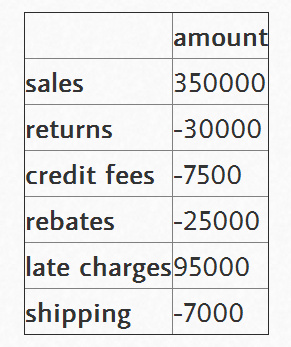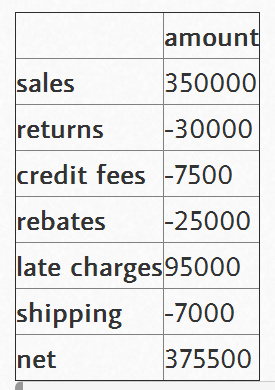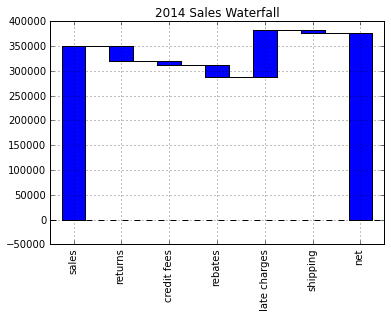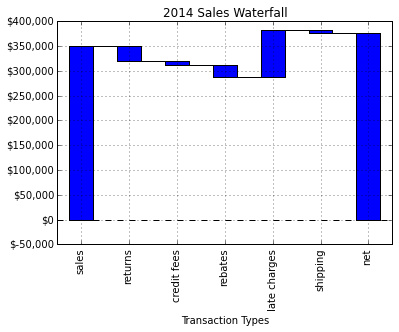教你用Python创建瀑布图(1)
教你用Python创建瀑布图(1)

介绍
对于绘制某些类型的数据来说,瀑布图是一种十分有用的工具。不足为奇的是,我们可以使用Pandas和matplotlib创建一个可重复的瀑布图。
在往下进行之前,我想先告诉大家我指代的是哪种类型的图表。我将建立一个维基百科文章中描述的2D瀑布图。
这种图表的一个典型的用处是显示开始值和结束值之间起“桥梁”作用的+和-的值。因为这个原因,财务人员有时会将其称为一个桥梁。跟我之前所采用的其他例子相似,这种类型的绘图在Excel中不容易生成,当然肯定有生成它的方法,但是不容易记住。
关于瀑布图需要记住的关键点是:它本质上是一个堆叠在一起的条形图,不过特殊的一点是,它有一个空白底栏,所以顶部栏会“悬浮”在空中。那么,让我们开始吧。
创建图表
首先,执行标准的输入,并确保IPython能显示matplot图。
- import numpy as np
- import pandas as pd
- import matplotlib.pyplot as plt
- %matplotlib inline
设置我们想画出瀑布图的数据,并将其加载到数据帧DataFrame)中。
数据需要以你的起始值开始,但是你需要给出最终的总数。我们将在下面计算它。
- index = ['sales','returns','credit fees','rebates','late charges','shipping']
- data = {'amount': [350000,-30000,-7500,-25000,95000,-7000]}
- trans = pd.DataFrame(data=data,index=index)
我使用了IPython中便捷的display函数来更简单地控制我要显示的内容。
- from IPython.display import display
- display(trans)

瀑布图的最大技巧是计算出底部堆叠条形图的内容。有关这一点,我从stackoverflow上的讨论中学到很多。
首先,我们得到累积和。
- display(trans.amount.cumsum())
- sales 350000
- returns 320000
- credit fees 312500
- rebates 287500
- late charges 382500
- shipping 375500
- Name: amount, dtype: int64
这看起来不错,但我们需要将一个地方的数据转移到右边。
- blank=trans.amount.cumsum().shift(1).fillna(0)
- display(blank)
- sales 0
- returns 350000
- credit fees 320000
- rebates 312500
- late charges 287500
- shipping 382500
- Name: amount, dtype: float64
我们需要向trans和blank数据帧中添加一个净总量。
- total = trans.sum().amount
- trans.loc["net"] = total
- blank.loc["net"] = total
- display(trans)
- display(blank)

- sales 0
- returns 350000
- credit fees 320000
- rebates 312500
- late charges 287500
- shipping 382500
- net 375500
- Name: amount, dtype: float64
创建我们用来显示变化的步骤。
- step = blank.reset_index(drop=True).repeat(3).shift(-1)
- step[1::3] = np.nan
- display(step)
- 0 0
- 0 NaN
- 0 350000
- 1 350000
- 1 NaN
- 1 320000
- 2 320000
- 2 NaN
- 2 312500
- 3 312500
- 3 NaN
- 3 287500
- 4 287500
- 4 NaN
- 4 382500
- 5 382500
- 5 NaN
- 5 375500
- 6 375500
- 6 NaN
- 6 NaN
- Name: amount, dtype: float64
对于“net”行,为了不使堆叠加倍,我们需要确保blank值为0。
- blank.loc["net"] = 0
然后,将其画图,看一下什么样子。
- my_plot = trans.plot(kind='bar', stacked=True, bottom=blank,legend=None, title="2014 Sales Waterfall")
- my_plot.plot(step.index, step.values,'k')

看起来相当不错,但是让我们试着格式化Y轴,以使其更具有可读性。为此,我们使用FuncFormatter和一些Python2.7+的语法来截断小数并向格式中添加一个逗号。
- def money(x, pos):
- 'The two args are the value and tick position'
- return "${:,.0f}".format(x)
- from matplotlib.ticker import FuncFormatter
- formatter = FuncFormatter(money)
然后,将其组合在一起。
- my_plot = trans.plot(kind='bar', stacked=True, bottom=blank,legend=None, title="2014 Sales Waterfall")
- my_plot.plot(step.index, step.values,'k')
- my_plot.set_xlabel("Transaction Types")
- my_plot.yaxis.set_major_formatter(formatter)


评论关闭